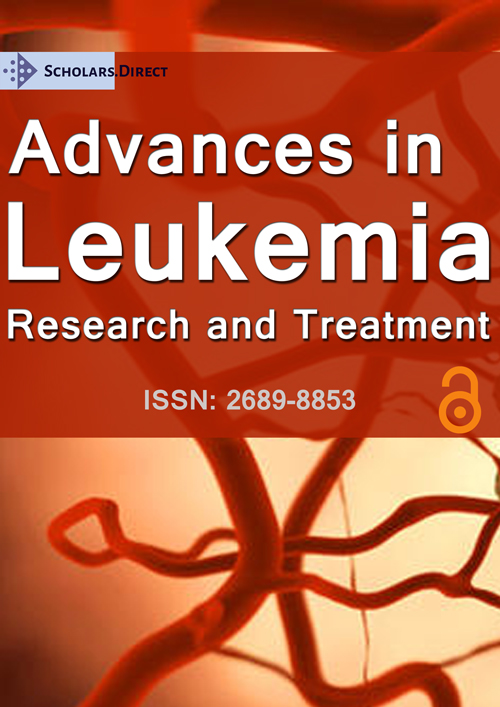Role of Allogenic Bone Marrow Transplant in Patients with Paroxysmal Nocturnal Haemoglobinuria
Paroxysmal Nocturnal Hemoglobinuria is an acquired clonal hematopoietic stem cell disorder that can present with hemolytic anaemia, thrombosis and aplastic anaemia.
There are different therapeutic approaches for PNH which do not cure the disease but can decrease its complications. Allogeneic bone marrow transplantation (BMT) can cure PNH [1] especially for younger PNH patients with aplastic phenotype [2].
37-yrs-old male patient presented with jaundice and passing cola colored urine. His blood parameters show Hb-6.5, WBC 6400, platelet count 2.6 lakhs, MCV-115, bilirubin-3.0, LDH-4980, Coombs test- negative, Urine hemosiderin positive. Bone marrow showed marked Erythroid hyperplasia, PNH screen positive of 56% (CD55, CD59).
He received multiple transfusions and trial of steroids with no benefit. He developed shortness of breath on exertion despite maintaining haemoglobin more than 10 g/dl. His Echocardiogram showed normal LV function. His pulmonary function tests revealed restrictive lung disease. He had high BNP (Brain natriuretic peptide) likely due to pulmonary hypertension with ongoing haemolysis, however pulmonary pressures were not measured. He had options of Eculizumab and Bone marrow transplant. In view of cost he chose to go with Bone marrow transplant.
Androgen therapy and Immuno suppressants can be tried [3] in early part of diagnosis which is not offered in view of failure to respond to steroids and pulmonary hypertension.
He had fully matched 10/10 Sibling Allogenic Hematopoietic Stem Cell Transplant with Fludarabine, Busulfan and ATG Conditioning. During conditioning chemotherapy, he had further rise in BNP to 5430 and had ST-T ischemic changes. Managed conservatively. Neutrophil engraftment occurred on day 12 and platelet engraftment on day 14. Patient discharged on day 18 post-transplant. He attained complete morphological recovery by day 20 and not needed any transfusions post-transplant. He continued immunosuppression with cyclosporine for 3 months maintaining target therapeutic levels between 100-200. He had not experienced any GVHD. Additional antimicrobial prophylaxis included acyclovir and septran for 1 year.
Post-transplant assessment after 30 days he had 100% donor chimerism and his PNH clone is RBC of 5-7%. After 6 months' flow cytometry was negative for PNH clone in all three cell lines with Hb-13.0, LDH-239. His Pulmonary functions, Echocardiogram noted to be normal. After one year of HSCT patient quality was improved without any symptoms with negative PNH clone.
Overall survival was 70% in matched unrelated donor allogenic bone marrow transplant among patients with paroxysmal nocturnal hemoglobinuria previously treated with eculizumab from a retrospective study of 21 patients from SFGM-TC centers [4].
We conclude Sibling allogenic bone marrow transplant is a relatively safe and cost effective alternative upfront treatment for transfusion dependent classical PNH patients who can afford Eculizumab treatment.
References
- Robert A Brodsky (2010) Stem cell transplantation for paroxysmal nocturnal hemoglobinuria. Haematologica 95: 855-856.
- Monia Marchetti, Giovanni Barosi (2014) Should I transplant this patient with paroxysmal nocturnal hemoglobinuria? a cost-effectiveness analysis of eculizumab versus allogeneic stem cell transplant. Blood 124: 735.
- Régis Peffault de Latour, Jean Yves Mary, Célia Salanoubat, et al. (2008) Paroxysmal nocturnal hemoglobinuria: Natural history of disease subcategories. Blood 112: 3099-3106.
- Vallet N, de Fontbrune FS, Loschi M, et al. (2018) Hematopoietic stem cell transplantation for patients with paroxysmal nocturnal hemoglobinuria previously treated with eculizumab: A retrospective study of 21 patients from SFGM-TC centers. Haematologica 103: e103-e105.
Corresponding Author
Dr. Padmaja Lokireddy, MD, MRCP, FRCPath, Consultant Haemato Oncology and Stem Cell Transplant, Apollo Cancer Hospital, Hyderabad, India.
Copyright
© 2018 Lokireddy P, et al. This is an open-access article distributed under the terms of the Creative Commons Attribution License, which permits unrestricted use, distribution, and reproduction in any medium, provided the original author and source are credited.




